Ambrose "Bo" McGurgan is checking the tyres on his six-axle lorry at the Applegreen truck stop near Castlebellingham, Co Louth, south of the Irish Border. It is the only check he will undergo before crossing over into Northern Ireland.
From the end of this month all that could change with the UK's exit from the EU on October 31st, the date British prime minister Boris Johnson wants Brexit to happen.
McGurgan fears the return of the dreaded customs checks of more than a quarter century ago. He remembers the hard border when 300 or 400 trucks could be parked up for hours awaiting customs clearance.
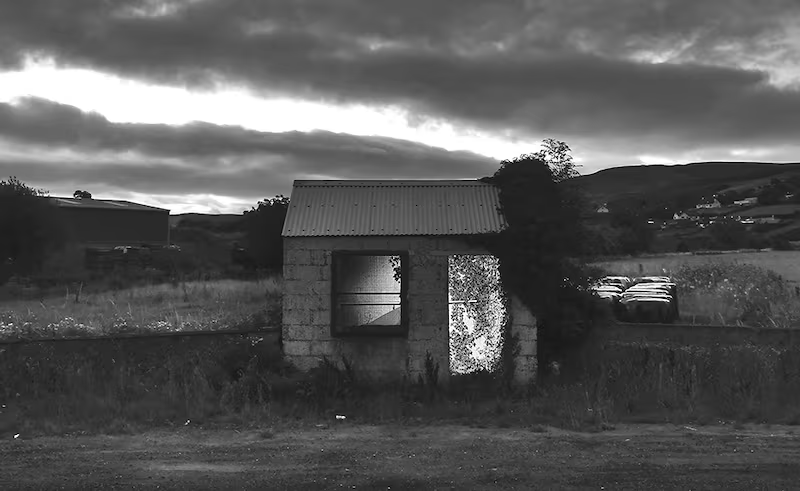
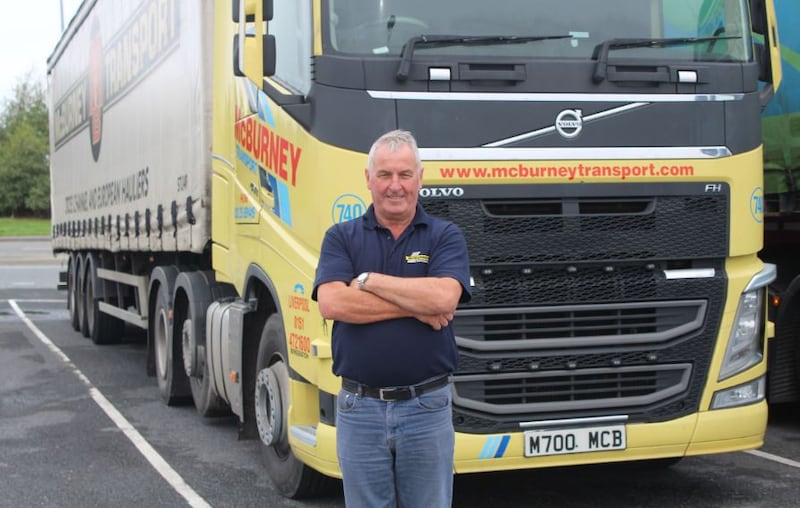
"It will be going back to square one, like in the 70s. It would be a disaster. You could be sitting all day in Dundalk waiting to get cleared," he tells The Irish Times.
It is 11am on a Monday and the Armagh man has been working for six hours and has already lifted and "tipped" a trailer in Dublin and is heading across the Border for another delivery in Newtownards, Co Down.
People don't realise how bad it is going to be. We, the older generation, we have done it all. We know how bad it is
He is hauling a mixed load of food and industrial goods – sauces and engineering bolts – but requires no paperwork as he drives, unhindered, across an open border between two jurisdictions currently within the EU. A return to the border of the past, that McGurgan waited hours to cross. is very real again.
Johnson’s government proposed to the EU last week to replace the contentious backstop guarantee to avoid a hard Irish border with a plan to impose a new customs border on the island of Ireland.
The deluge of paperwork, the queues of lorries, the hours-long delays, the potential targeting of customs officers by people upset with the return of a visible border “would be a disaster,” says McGurgan.
“People don’t realise how bad it is going to be. We, the older generation, we have done it all. We know how bad it is. There will be customs men shot. There will be. Everybody is fighting for a loaf,” he said.
McGurgan's truck was one of 6,639 goods vehicles to cross the Border on the A1 dual-carriageway between Dublin and Belfast last Monday. This is the busiest crossing on the Border between the Republic and Northern Ireland. Traffic counters operated by Transport Infrastructure Ireland, the agency monitoring the State's roads, show that on average five goods vehicles crossed this point of the Border every minute on Monday.
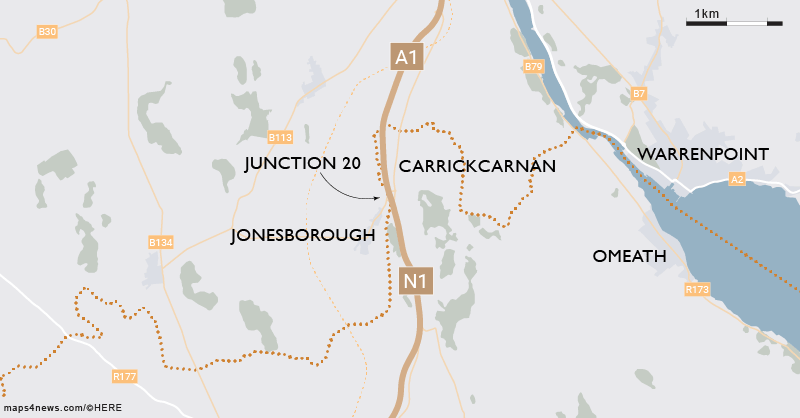
This is where the impact of the UK leaving without a deal has the potential to cause the most complications.
Next to McGurgan's truck is fellow haulier Brendan McParland, also a veteran Border-crosser. He is heading to Dungannon, Co Tyrone, with a load of peat after dropping plasterboard in Athy, Co Kildare.
He usually hauls European steel, landed at Warrenpoint in Co Down, across the Border to Dublin, Kilkenny or Carlow. Normally he can complete two return runs to Dublin in one day from Warrenpoint.
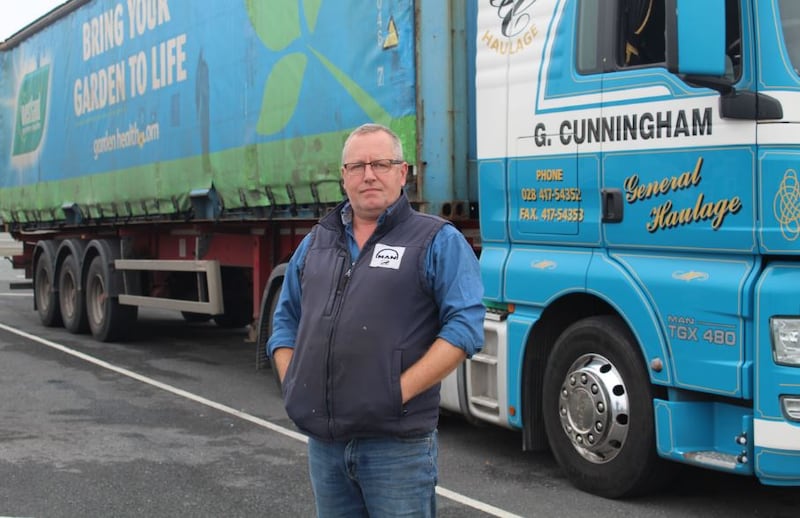
“If the Border was to come, you couldn’t guarantee you would even get one load done,” he said, munching on a sandwich in the cab of his lorry.
Michael Harbinson is one of several lorry drivers stopped at Applegreen transporting Coca-Cola products from its manufacturing facility in Knockmore Hill outside Belfast to customers in the Republic.
He believes an all-island economic unit is the way to avoid a hard Border. Not everyone wants this when it comes to both customs and EU single market rules north and south. The DUP also wants Northern Ireland to be able to vote to opt in to an all-island zone covering EU single market rules for goods every four years.
“If the North takes a deal still tied with the South, it is the best of both worlds. It is the DUP who is ruining it. They just stand firm in their stance,” said Harbinson.
How many back roads are there across the Border. It is not doable, simply not doable
At the last junction before the southern M1-N1 crosses the Border and turns into the northern A1 there is a fuel service station. It lies between Jonesborough, Co Armagh, and Carrickcarnan, Co Louth.
Colin Byrne, one of the pump attendants of the junction 20 service station, has no clue how the UK and EU would manage this Border if Britain leaves without a deal.“That’s the six million dollar question. Sure how many back roads are there across the Border. It is not doable, simply not doable,” he said.
Johnson has ruled out customs checks at or near the Border but has not specified in his plan where "designated locations" for some required checks might be. Byrne offers a foretaste of how checks might work: "every once in a while," he says, the Garda and customs check vehicles at the southbound exit 18 off the M1 into Dundalk. "If you saw the mayhem that that causes," he said.
On the bridge over the A1 dual-carriageway next to the Carrickdale Hotel there is a constant drone of noise as an "artic" or smaller "rigid" lorry or a light goods vehicle is always coming or going.
This is the north-south White Van Man highway.
Between 5am and 7pm last Monday – the busiest period of the day – 5,722 goods vehicles cross the Border. That is one goods vehicle every eight seconds. This traffic is split 50:50 in either direction.

"It shows trade is equally balanced going in either direction," said Séamus Leheny, policy manager of the Freight Transport Association, speaking loudly to be heard over the hum of traffic on the bridge.
“It is the artery of trade on the island of Ireland. It connects the two largest cities and to have any type of barrier on this, or diversions, or checks, it would inhabit trade and growth economically on either side of the Border here.”
Interrupting the flow of traffic here would have a huge impact, he says; lorries would “soon stack up” and could be waiting hours if they had to have paperwork inspected or their load physically inspected.
The stakes on finding a fix to the Brexit-Border conundrum are high. Leheny explains that five times as much freight crosses the Irish Border than moves between Northern Ireland and Britain, the North’s biggest market, but it is lower in value because it is mostly ingredients and components, and not completed products.
“What we make in Northern Ireland, it is comprised of bits and pieces sourced from every corner of the island of Ireland. If we have a hard border, the existence of those products that we make in Northern Ireland are jeopardised because you would have delays, tariffs and the sanitary controls as well,” he said.
In the retail game, this Border crossing is an essential supply chain route for multinationals. Northern Ireland supermarkets are stocked from distribution centres in the Republic, and vice versa. Then there are the food products made with ingredients coming from both north and south of the Border.
Aodhán Michael Connolly, director of Northern Ireland Retail Consortium, says that a supermarket chicken salad sandwich can have ingredients involving six border movements (north-south and east-west, between the North and Britain), while "the humble cottage pie" can have eight, including a cheese topping produced and processed on different sides of the Border. Each movement involves tariffs so the overall costs could be huge.
“That border crossing isn’t just to move goods A to B. It is a lifeline to the supply chain and to those small and medium-sized enterprises right down to the farmers who are in our supply chain,” he said. “If there isn’t frictionless movement across that border, each of those costs will have to go down the supply chain and it is going to make things tougher for the Northern Ireland consumer.”
Connolly sees Johnson’s plan as “unworkable” if it is the final deal because a customs border would amount to a hard border, but it is “progress” to open negotiations because it includes an all-island zone for goods.

Driving one of his nine trucks across the Border on the A1, Declan Trainor, a cattle and goods haulier, believes the island of Ireland should be “treated as a whole and as one island”.
He has no idea how the Border, just a few hundred metres from his office at Carrickcarnan, will look on November 1st, or how he will be able to continue transporting tiles from mainland Europe to Northern Ireland.
“It is the unknown. That is the scary part. The Government hasn’t really said how to prepare for it. They are only guessing themselves now so how are you supposed to prepare?” he said. “You don’t know whether it is a dance you are going to or a war. Sure how do you dress for it?”
Speaking a few days later, Trainor says Johnson’s “two borders for four years” proposal has left him even more confused. It has also made people who rely on free trade and free movement of goods across the Border “desperate,” he said.
“Whatever concern we had, we are more concerned now,” he said.
How busy is the M1/A1 crossing?
The Border crossing on the M1 motorway/A1 dual-carriageway between Dublin and Belfast is the busiest thoroughfare along the 499-kilometre open frontier between the Republic and Northern Ireland.
The four-lane crossing between Newry and Dundalk is about five times busier than the next busiest crossing over the Blackwater river between Emyvale, Co Monaghan, and Aughnacloy, Co Tyrone, based on traffic figures counted daily by Transport Infrastructure Ireland, the State agency that manages the Irish road network.
The agency uses a system of counters under the surface of strategically important roads across the country that can differentiate vehicles by wheel axle lengths. This allows the agency to gather data and analyse the volume of traffic and type of vehicles passing on the road for every hour of every day.
The counter at Junction 20 on the A1 at Ravensdale between Jonesborough, Co Armagh, and Carrickcarnan, Co Louth, showed that Monday, September 30th – a month before the UK's scheduled exit from the EU – was a typically busy day for traffic for this major transport route on the island of Ireland.
Some 25,301 vehicles crossed the Border over the 24-hour period: 18,175 cars, 6,639 goods vehicles (including the heaviest articulated lorries), 318 buses and 24 motorbikes. That means 17 vehicles crossed the Border on average every minute last Monday. One goods vehicle crossed the Border every 12 seconds.
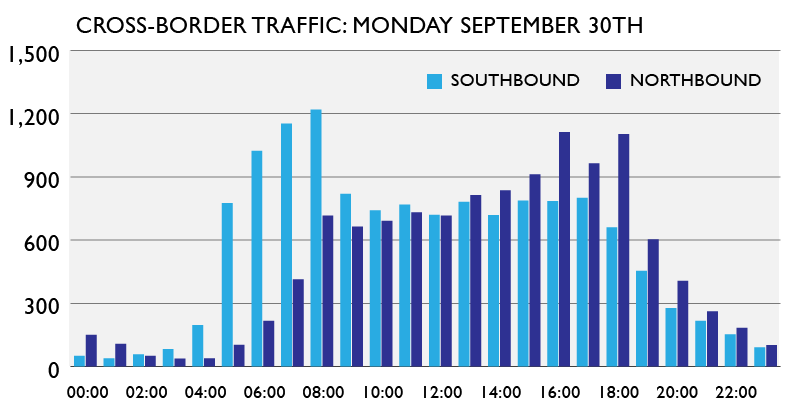
Hauliers, traders and businesses along the Border say any kind of delays stopping traffic on this corridor after Brexit would quickly result in heavy congestion and tailbacks.
The busiest times of day are during the morning rush-hour between 8am and 9am, when traffic volumes peaked at 1,935 vehicles, and the late afternoon peak between 4pm and 5pm at 1,897 vehicles.
The bulk of the traffic crosses the Border between the hours of 7am and 7pm when 19,625 vehicles were counted last Monday, or on average of 1,635 an hour.
The traffic is evenly split between northbound and southbound vehicles. However, more than twice as many goods vehicles head southbound between 5am and 9am – making deliveries to the Republic or transporting goods to Dublin Port in time to make the 8am ferry departures to England out of Dublin Port.
This route is a critical artery for goods travelling from Northern Ireland south into the Republic. Some 3,425 goods vehicles crossed the Border heading south into the Republic last Monday.

This worked out an average of 143 per hour. In other words, one goods vehicle crossed the Border into the Republic on the main Dublin-Belfast road every 25 seconds last Monday.
To put this in a national context, this part of the A1 is almost as busy or busier every day than the main Dublin to Galway M4 road at Kinnegad (26,400 vehicles on average a day), the main Dublin to Cork M7 road at Portlaoise (25,700 vehicles) and than the main Dublin to Wexford M11 road at Arklow (22,800 vehicles).
Cross-Border workers
Ten minutes drive south of the Border, dozens of parked cars – nearly all Northern Irish-registered vehicles – line either side of the road off Junction 17 of the M1 near Dundalk in Co Louth.
They belong to Northern Irish tradesmen, mostly from across the Border in south Armagh, who park and car-pool into the Republic for work. They are mostly construction works, plumbers and electricians.

“There are thousands of people going to and from work every day, crossing the Border every couple of minutes. There are thousands and thousands of guys down south working and Dublin is most of where the work is,” said Neil Byrne, a plumber from Mullaghbane near Forkhill.
The Armagh man usually arrives at around 5.50am to park his car and catch his lift to Dublin. He has worked “all over the south” including in Kildare and Athlone.
Byrne says he and his fellow commuters to the Republic are concerned about a crash-out Brexit and the return of a hard border resulting in hours and hours of traffic delays crossing the Border.
He doesn’t believe a hard border would work; it does not make sense to have one, he says. “It is one small country in my opinion: it doesn’t matter whether you are north or south, Ireland is Ireland and you have to get to your work regardless,” he said.
Delays and traffic jams are not his only worry.
“If there’s a Border, it has the whole issue of the Troubles starting again because in my own personal opinion it is going to happen the exact same way it did back then: customs guys get attacked, then there is a police presence, then they get attacked and then there is a military presence,” he said. “It doesn’t take much to set it off.”























